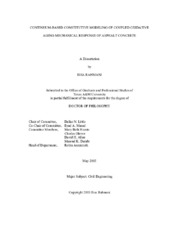| dc.description.abstract | Oxidative aging is known to be one of the main contributors to reducing the service life of asphalt pavements. Asphalt concrete becomes stiffer and more brittle when it reacts with oxygen. The aged asphalt pavement is more susceptible to crack development and damages when subjected to repeated traffic loading. The aim of this dissertation is to develop and validate a mechanistic-based aging constitutive relationship based on an aging state variable.
Oxidative aging of asphalt concrete involves a thermodynamic process between reactive molecules of asphalt and oxygen. The repercussion of such a process is a change in mechanical, macroscopic properties of the material. This phenomenon is accounted for in this study by formulating an aging constitutive equation, based on continuum theory, in which the aging state variable is correlated with oxygen content via an evolution function. In this aging constitutive equation, the rate of change of the aging variable and oxygen content are formulated as conjugate variables. In other words, oxygen content is considered as the driving force for the rate of change of the aging variable. The rate of change of the aging state variable is expressed as a function of oxygen content, temperature, and level of aging at any given time.
The behavior of asphalt concrete is modeled using the PANDA (Pavement Analysis Using a Nonlinear Damage Approach) framework, which accounts for the viscoelastic, viscodamage, and viscoplastic behavior of the materials. The time-dependent response of aged asphalt concrete is investigated by introducing the aging state variable to Schapery’s viscoelastic model. The aging state variable causes an increase in the stiffness and viscosity of the aged material by decreasing the compliance terms and the retardation times. Because the viscoelastic, viscodamage, and viscoplastic components of PANDA are coupled or interrelated, the change in the viscoelastic properties, because of aging, affects the overall mechanical behavior of asphalt concrete.
The aging constitutive equation is calibrated using data obtained from laboratory experiments, and then its predictions are validated against independent experimental data. It is shown that the proposed model is capable of predicting mechanical response of aged asphalt concrete specimens subjected to different loading conditions. | en |


